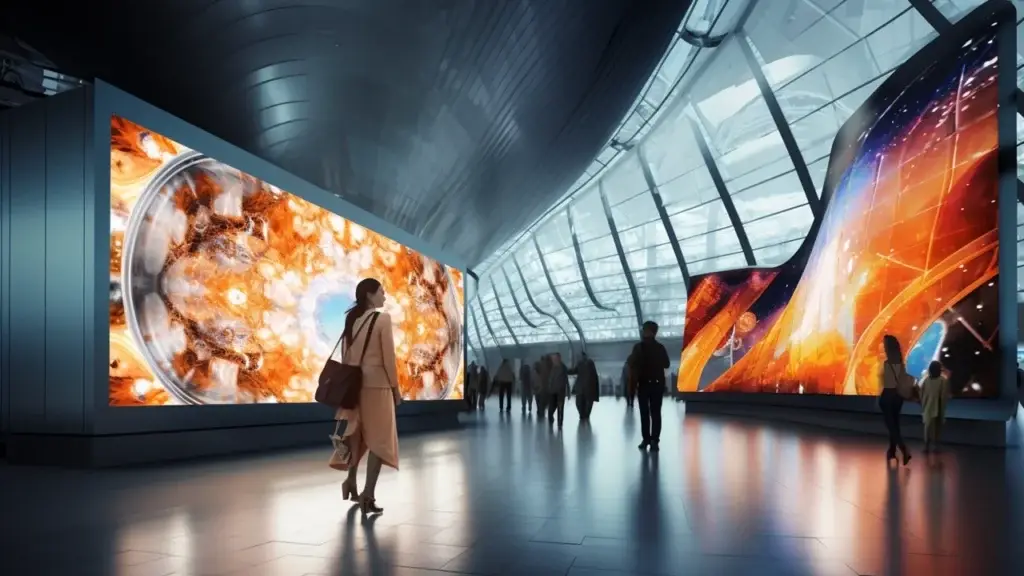LED Displays are a versatile solution for various visual communication needs, with different types specifically designed for indoor and outdoor environments. The selection between indoor and outdoor LED displays depends on several factors, such as brightness, color accuracy, viewing angle, and durability. Below is a detailed comparison:

Indoor LED Displays
Characteristics:
- Brightness: Indoor LED displays typically have a lower brightness level, ranging from 600 to 1500 nits. This is because indoor environments do not require displays to compete with direct sunlight.
- Color Accuracy: High color accuracy and contrast are essential, as indoor displays are often viewed from close distances. They use fine-pitch LEDs (small pixel pitch), which provide detailed and sharp images.
- Viewing Angle: Indoor displays are designed to have a wider viewing angle, usually around 140-160 degrees, to accommodate viewing from various positions within a room.
- Durability: Indoor LEDs have less stringent requirements for weatherproofing. They are usually rated for IP20 or IP30, providing minimal protection against dust and no protection against water.
- Pixel Pitch: The pixel pitch can be very small, from P1.2 to P5 (where “P” denotes the distance in millimeters between the center of two adjacent pixels), which is suitable for close viewing distances.
Common Applications:
- Retail Displays: Used for advertisements, promotions, and product showcases inside stores and shopping malls.
- Corporate Environments: Used for presentations, conference room displays, and digital signage in lobbies.
- Entertainment Venues: Screens in theaters, museums, and exhibitions for immersive experiences.
- Broadcast Studios: LED backdrops that require high color fidelity and refresh rates.
Specific Types of Indoor LED Displays:
- Fine-Pitch LED Displays: With pixel pitches below 2.5 mm, ideal for high-resolution applications such as corporate settings and control rooms.
- Transparent LED Displays: Allow for see-through visuals, commonly used in retail store windows and architectural integrations.
- Flexible LED Displays: Can be bent and shaped for creative installations, such as curved walls or artistic displays.
Outdoor LED Displays
Characteristics:
- Brightness: Outdoor LED displays have significantly higher brightness levels, typically ranging from 4000 to 10,000 nits, to ensure visibility under direct sunlight.
- Color Accuracy: While outdoor displays prioritize brightness over color accuracy, advancements in technology have improved their color reproduction capabilities. They usually balance between brightness and color fidelity.
- Viewing Angle: Outdoor LEDs also offer a wide viewing angle, but due to their placement, they might not need as extensive a range as indoor displays. A typical viewing angle is around 120-150 degrees.
- Durability: Outdoor displays must withstand harsh weather conditions. They are rated at least IP65, which means they are dust-tight and can resist water jets from any direction. They also have reinforced cases to protect against impacts and temperature changes.
- Pixel Pitch: Outdoor displays typically have a larger pixel pitch, ranging from P6 to P16, as they are designed for longer viewing distances.
Common Applications:
- Billboards and Advertising: Large screens along highways or on building facades for dynamic advertisements.
- Stadiums and Arenas: Scoreboards and live action displays that need to be visible from a distance.
- Public Spaces: Information displays in city centers, transportation hubs, and outdoor events.
- Architectural Displays: Integration into building designs for creative visual effects or dynamic facades.
Specific Types of Outdoor LED Displays:
- Fixed Outdoor LED Displays: Permanent installations for advertising, typically with a pixel pitch of P8 or greater.
- Rental and Staging LED Displays: Designed for quick assembly and disassembly, often used in concerts and temporary events, with a range of pixel pitches.
- Perimeter LED Displays: Used around sports fields for advertising, generally with higher durability and impact resistance
Key Differences Between Indoor and Outdoor LED Displays:
- Brightness:
- Indoor: Lower brightness, optimized for viewing in controlled lighting conditions.
- Outdoor: High brightness to combat direct sunlight.
- Durability:
- Indoor: Less durable, not weatherproof, lower IP rating (IP20-IP30).
- Outdoor: High durability, weatherproof, higher IP rating (IP65 or higher).
- Pixel Pitch:
- Indoor: Smaller pixel pitch for close viewing (P1.2 to P5).
- Outdoor: Larger pixel pitch for distant viewing (P6 to P16).
- Color Accuracy:
- Indoor: Higher color accuracy and contrast for detailed viewing.
- Outdoor: Good color accuracy but prioritized for brightness and visibility.
- Viewing Angle:
- Indoor: Wider viewing angles due to the close and varied viewing positions.
- Outdoor: Sufficient viewing angle for long-distance visibility.
For more information, contact us on +966 11 229 3041 or fill in the form below.
FIll out the form below and we will cantact you as soon as possible
